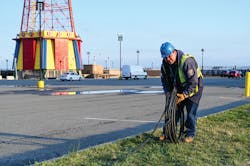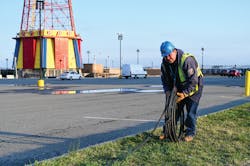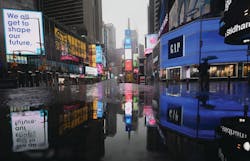Utilities Face New Kind of Disaster with COVID-19
The electric utility industry is not known for its ability to move quickly. From the time of George Westinghouse, Nikola Tesla and Thomas Edison’s Current War to the widespread use of home electronics in the 20th century, the fundamentals of the industry did not change perceptibly. Then there are times like these, with COVID-19, where it feels like decades of change happen in mere days.
As in a traditional economic downturn, industry and business suddenly were using less power. However, in this unique situation, the industry saw more workers shifting to a work-from-home posture to maintain social distancing.
How could utilities and grid operators maintain both social distancing and a reliable power supply? Could the mutual assistance system safely be relied on as it had been in the past? How might utility load patterns be affected in the short and long terms? Would critical staff need to shelter in place at critical infrastructure sites? These were questions electric utilities around the world had to consider when the coronavirus pandemic hit, and they had to act fast to adapt to the changing conditions.
Electricity Demand
David Roop, a recent retiree who spent 43 years working with utilities, including Dominion Energy Inc., said U.S. utilities have a culture of helping one another and could make use of their mutual assistance network, including contract workforce, if needed.
“I believe they will use this program but will consider how they stage personnel (limit large gatherings), ensure hygiene for all that arrive is being practiced and practice social distancing where they can,” Roop said. “Efficiency may not be as great, but the work will get done.”
Roop also thinks the time of year the outbreak first appeared in the U.S. is fortunate, as demand typically begins dropping in Spring months.
“Given the mild weather, I doubt a tremendous change other than colleges, commercial and industrial load patterns as these industries become impacted by this. Data center load is fairly consistent, so this will probably not change much,” Roop noted.
In Europe, the impact of the virus on grid operators in some countries has matched the impact of weather in an average year — effectively doubling the decline in demand the industry usually expects. In COVID-19 hot spot Italy, grid operators saw a reduction in electric demand, with some reports as high as 18% to 21%. After March 9, 2020 — when the Italian Prime Minister issued a national quarantine — there was a 3-GW reduction.
The impact was less sharp in other European countries where the virus’ affect was less severe than in Italy. Demand in Spain over the weekend of March 14-15 was down 5.6% compared to the previous week, although the week overall was broadly in line with the previous year. French demand was more than 15% below normal levels in March 2020, compared to the prior 12 weeks, but the effect was almost equally divided between the weather impact (8% reduction) and COVID-19 impact (8% reduction). There was no detectable change in the U.K. during the same time period, but it also was slower to enact changes like school and university closures. Some European countries had a drop in nighttime demand, which could be attributed to closures of bars and restaurants as well as the cancellation of large concerts and other live entertainment.
In the U.S., the Midcontinent Independent System Operator Inc. (MISO) reported system demand in March 2020 was down 18% compared to March 2019 and down 13% month to date compared to the March average since 2014. ISO New England Inc. reported a decline in system demand of approximately 3% to 5%, compared to what normally would be expected under weather conditions in the region.
Initial Utility Responses
One of the first major changes made in the face of the outbreak was the decision by utilities to halt power shutoffs for nonpayment. Many, if not most, utilities made this decision without a regulatory or state legislative mandate. As Duke Energy Corp. put it March 13 when it announced the policy, this was a matter of supporting the community in an uncertain time.
“Since many of our customers may be facing unusual financial hardship, we are suspending disconnection for nonpayment effective immediately,” according to a joint announcement from Duke Energy and its unit Piedmont Natural Gas Co. Inc., which suspended service shutoffs for all home and business accounts in seven states.
Austin Energy, the Sacramento Municipal Utility District, San Diego Gas & Electric and FirstEnergy Corp. were some but not all the utilities that made similar announcements early in the pandemic. Within a week of these utilities issuing such announcements, it was more a matter of finding out which utilities had not temporarily ended shutoffs, as almost all already had.
Some utilities, like DTE Energy and Consumers Energy, offered assistance to a narrower scope of their customers, limiting cutoff suspensions to elderly and low-income customers within a certain designated time period. Others offered assistance to a wider swath of their communities. Eugene Water & Electric Board suspended service shutoffs for all residential and commercial customers until further notice, suspended late fees, expanded its bill assistance program to include job loss benefits to qualifying customers, allocated double funding to its customer care bill assistance program, deferred energy-efficiency loan payments on request and offered flexible payment arrangements on a case-by-case basis.
Other changes utilities made early on included closing offices, stepping up sanitation and cleaning of important facilities, and communicating good hygiene practices to all employees. The New York Power Authority displayed screens constantly in its headquarters with tips on handwashing, social distancing and cough etiquette.
COVID-19 led to small policy changes, but it also changed the course of much bigger unfolding events in the utility industry. Before the pandemic, most would have said the most significant story in the utility world was the ongoing Pacific Gas & Electric Co. (PG&E) bankruptcy and the feud between the investor-owned utility and California’s regulators and government, embodied by Gov. Gavin Newsom. As much doubt about PG&E’s recovery plans as Newsom showed before the pandemic, after its effect on Wall Street and jobless numbers, Newsom’s stance softened enough for him to drop his opposition to the US$23 billion plan for PG&E to reemerge from bankruptcy in June 2020.
Transmission Work Continues
Where some things changed, others stayed the same. For the most part, major T&D construction projects and upgrades continued apace, even as many workplaces ground to a halt or slowed down markedly.
Entergy Corp. told TransmissionHub on March 17 it was confident in its business continuity plan, adding it was specifically designed even for pandemic conditions. At that time, Entergy had not postponed or delayed any large generation or transmission projects.
“We are planning for the continued safe operation of our power plants, transmission and distribution system through a process to identify which employees must work on-site, which can work from home, [and] which must work in the field…,” Entergy stated. We are limiting access to areas where essential employees must be on-site, such as control rooms and control centers. We are sanitizing and securing access to those areas in a conscious effort to maintain a healthy work environment for those key employees.”
American Transmission Co. (ATC) said on March 18 its work also was proceeding as planned, albeit with some additional health precautions for workers.
“We and our contracted partners are following government guidelines for personal health and safety, including distancing and handwashing. With the exception of critical roles, our office staff is working remotely from home. We are continually monitoring the situation and will make adjustments as necessary,” said Jody Lau, communications project manager with ATC.
Protecting Critical Workers
The spread of the coronavirus clarified the value of the job utility workers do. The U.S. Cybersecurity and Infrastructure Security Agency quickly designated line workers and vegetation management workers as critical and essential to continued infrastructure viability. The designation included call center operators, utility workers, maintenance technicians, reliability coordinators, balancing authorities, mutual assistance personnel, information technology and operational technology staff, cybersecurity engineers, vegetation management crews, remediation technicians and instrumentation technicians.
Obviously, many of these workers cannot do their jobs from a remote location and would still have to report to an office or jobsite. As the International Brotherhood of Electrical Workers (IBEW) and its partners at the National Electrical Contractors Association pointed out, this work cannot be done if critical workers or their families are sickened. The unions released a National Disease Emergency Response Agreement on March 18 providing guidance to essential workers to help keep their workplaces safe, staffed and healthy.
The agreement instructed employers to notify employees if a worker or jobsite was found to be exposed to coronavirus and instructed workers to report potential symptoms as soon as possible to ensure a safe workplace. The IBEW also called for no adverse actions to be taken against employees who refuse to come to a jobsite where there might be imminent danger of infection or against a worker who was quarantined by official order or a self-quarantine due to possible exposure.
The Tree Care Industry Association (TCIA) and the International Society of Arboriculture (ISA) released a set of best practices March 23 to safeguard workers in the tree care industry. The TCIA’s COVID-19 website instructed arborists to consider temporary absenteeism as the best way to support employees and the health of their company as well as limit the spread of the virus in their community.
To determine which work might be essential under federal, state and local health or business closure orders, TCIA and ISA recommended companies review their backlogs and separate safety work directly related to client or public safety. Essential work could include road safety clearance, mitigating storm damage, removing fuel trees in a fire hazard area, utility line clearance and other jobs.
Utilities also had to consider the job that needs to be done at the meter. Consolidated Edison Inc. (ConEd) halted all meter reading and smart meter installation jobs in response to the coronavirus outbreak.
“Nothing is more important than health and safety,” said Tim Cawley, the president of ConEd. “We want to protect everyone while providing the safe, reliable service our customers need. While many of our work activities have been put on hold, we are focusing on system infrastructure work that ensures safety and reliability.”
Looking out for the Community
Several utilities took COVID-19 as a cue to show not only their importance to the communities they operate in but also their responsibility to support their communities.
Public Service Enterprise Group (PSEG) utilities did this in several ways. PSEG announced March 24 it would donate 50,000 N95 filtration masks that were in short supply to local health systems and first responders. PSEG called for other utilities to make similar donations out of their own inventories of emergency supplies.
On the opposite coast, PG&E donated 480,000 N95 masks and 470,000 surgical masks to the Office of Emergency Services, a central repository for disaster readiness supplies in California. PG&E and its parent company PG&E Corp. also contributed US$1 million to nonprofit organizations focused on food insecurity as well as small businesses to help with the uncertainty and economic impacts of the public health emergency. The donations came from shareholder funds, not customers, according to PG&E.
PSEG Long Island and its foundation also made donations to local food banks, including US$45,000 to the Island Harvest Food Bank, which serves children whose access to food was partially dependent on meals served at schools, which are now closed because of COVID-19.
In addition to giving to local food banks, Connexus Energy donated to Meals on Wheels to help get food to those who need it most. The utility said on Twitter that donated lunch bags were used to hang the meals on doors to ensure safe social distancing.
It is always heartening to see utilities working as good corporate citizens; however, the time may come as this outbreak drags on when utilities need support. Particularly smaller cooperatives and municipal utilities could find themselves sheltering in place for weeks or months, and this is a resource-intensive prospect if they cannot access the same needed supplies as larger utilities.
Taking Shelter, Doing the Work
At the time of this writing, most U.S. utilities had plans to put workers into a shelter-in-place stance but were not yet actively taking shelter. In Europe, where COVID-19 spread sooner and the state of the pandemic was later, utility workers already were hunkering down.
For example, Austria’s Wien Energie AG had a staff of 53 technicians barricaded inside a power plant in Vienna, eating, sleeping and working in shifts of two weeks to avoid infections that could interrupt electric service.
The U.K.’s Energy Networks Association reported in mainland Britain that all work except essential maintenance was called off, and the official government recommendation was to work with a skeleton crew of 20% staff only.
Sweden’s Vattenfall AB was one utility that began preparations for COVID-19 early on in January 2020. Its nuclear facilities were operating “under a state of preparedness,” and it was following authorities’ recommendations along with its own continuity plans for its power grid operations from Germany to the U.K., said Vattenfall CEO Magnus Hall.
Changing an Industry
The predictions failed to match the new reality everyone now lives in, post-COVID-19: a global economic crisis that corresponded with a humanitarian crisis and a workplace crisis. The disease was expected, but the scale and speed of its impacts were not.
The utility industry, with its aging workforce and specialized talent pool, perhaps understood it must protect its people carefully. The workers who run power plants, power lines and power grids are highly trained and educated, and therefore not easily replaced.
It is true utilities probably could benefit from more capacity to do their work remotely. Perhaps COVID-19 is teaching them this lesson. In the past few months, like many other companies in the U.S. and worldwide, electric utilities likely have learned a lot about what is needed to work remotely — which employees need virtual private network (VPN) access, how many people can log in at once before an issue occurs, which remote conferencing service works best, and how many extra laptops and tablets are needed for workers.
The advent of technologies like smart meters and remote asset management provided some protection from the virus, but people still need to congregate in groups to keep these technological labor savers working. Technologies such as cloud-based remote operations solutions and intelligent remote asset management as well as using cheaper and better sensors for remote monitoring, systems and control have promised more efficient operations for utilities for many years now, but discussions on actually deploying these measures have taken on a new urgency in the post-COVID world. What will the new normal look like for utilities?
The challenges the industry faces were magnified by COVID-19, but the impact of it all may not be completely known without the benefit of years to look back on. Addressing a problem just in time may no longer be good enough. Just as the coronavirus spread to other countries before the problem’s scope was fully understood, utilities cannot wait for the next big disruptive event to arrive before preparing for it.
Editor’s Note: We are still hunkering down in our homes and social distancing as much as possible when we have to be out for essential activities. And utilities are still responding to a new kind of disaster by continuing reliable operations, protecting workers and stepping up to help when they can. The situation is still fluid; visit our Disaster Response page at https://www.tdworld.com/disaster-response for latest news regarding the industry's response to COVID-19.
About the Author
Jeff Postelwait
Managing Editor
Jeff Postelwait is a writer and editor with a background in newspapers and online editing who has been writing about the electric utility industry since 2008. Jeff is senior editor for T&D World magazine and sits on the advisory board of the T&D World Conference and Exhibition. Utility Products, Power Engineering, Powergrid International and Electric Light & Power are some of the other publications in which Jeff's work has been featured. Jeff received his degree in journalism news editing from Oklahoma State University and currently operates out of Oregon.






